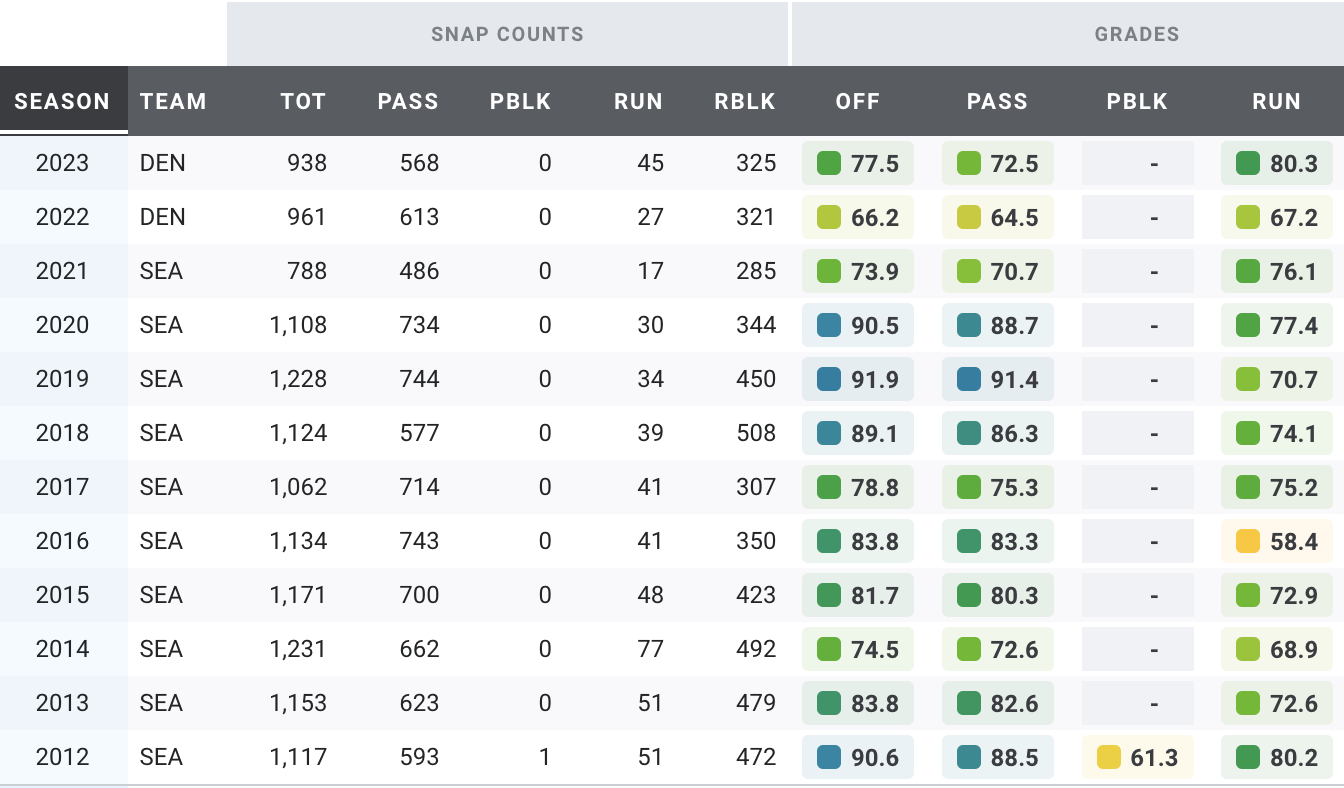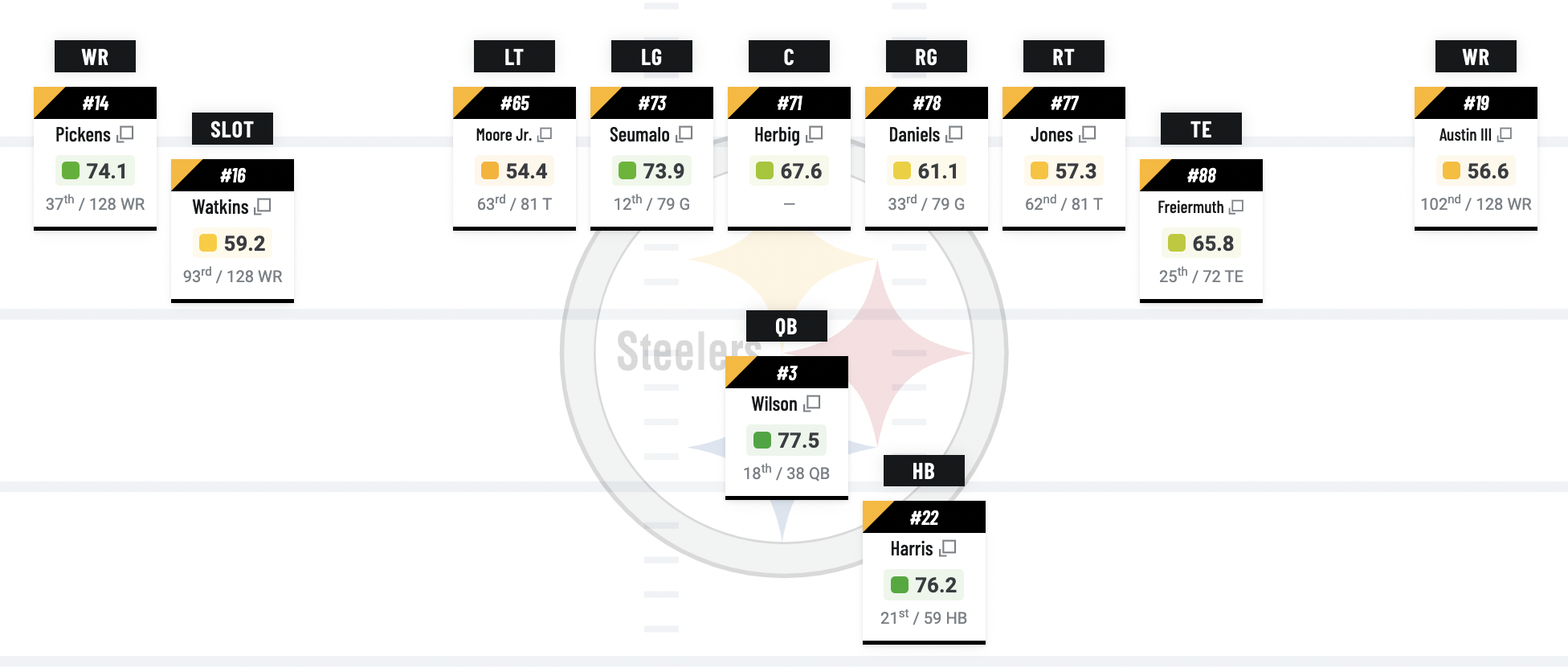• A high ceiling and a contingency plan: Russell Wilson could very well return to his peak in offensive coordinator Arthur Smith's system. But if not, Justin Fields is waiting in the wings.
• Smith's system takes pressure off the quarterback: Smith generally employs a run-heavy attack, and his system in Tennessee allowed Ryan Tannehill to be the NFL's highest-graded passer in 2019.
• Get a head start on fantasy football: Use PFF's fantasy football mock draft simulator to create real live mock draft simulations to prepare for your live draft!
Estimated Reading Time: 5 minutes
One of the most interesting storylines heading into the 2024 NFL season is Russell Wilson trying to revive his career in Pittsburgh.
Wilson is coming off a disastrous tenure with the Denver Broncos, such a failure that the Broncos are paying him $39 million in 2024 to play for the Steelers and not for them.
Consequently, the Steelers upgraded at quarterback for pennies on the dollar and paired Wilson with new offensive coordinator Arthur Smith in the offseason.
That Smith-Wilson dynamic has a very broad range of possible outcomes.
On one hand, Smith’s offense does a lot of things to protect quarterbacks, taking the burden off their shoulders and letting them excel on the opportunities they do have by being more efficient. Ryan Tannehill earned PFF overall grades of 92.5 and 90.3 in back-to-back seasons for the Titans under Smith. And it wasn’t because Tannehill suddenly became the best quarterback in the game.
There was an understanding that the offense, leaning heavily on running back Derrick Henry at the time and using a lot of play action, was turbocharging Tannehill’s efficiency.
In 2019, he led the league in PFF passing grade (91.0) and yards per attempt (an absurd 9.6) but ranked just 10th in passing yards per game in his 10 starts.
That approach should create echoes of prime Russell Wilson in Seattle, where the public narrative was “Let Russ Cook!” but the Seahawks coaching staff seemed permanently reluctant to ever put the game in his control as much as other quarterbacks throughout the league.
Russell Wilson Career PFF Grades

Subsequent events have muddied the picture, but the Seahawks under Pete Carroll seemed to always believe that Wilson was at his best if he was being protected by the offense more than some other quarterbacks, and they could maximize his efficiency and his impact in that way.
Only San Francisco ran the ball more last season than Smith's Falcons as a percentage of their offensive play calls — and they were playing with a significant lead far more often. On first down, the Falcons had the highest run rate in the game (56.2%). And overall, only the Vikings used play action more often.
Arthur Smith could well be the key to rediscovering the best form of Wilson as a starting quarterback, bringing back the player who was so good for the Seahawks for a decade.
On the other hand, there are ways that Smith’s offense differs from those of Seattle during Wilson’s peak years — some that may lean on his weaknesses more.
Smith’s scheme likes to target the middle of the field — though perhaps less than the narrative would suggest — and that’s an area Wilson has never excelled in, even at his best.
Imagine a box in the middle of the field 15 yards in from each sideline and between the line of scrimmage and 20 yards deep off the line. Last season, Smith’s Falcons targeted that box 26.5% of the time, just below the league average of 27.5%. During Tannehill’s breakout season in Tennessee, the number was 31.5%.
The proliferation of the Shanahan and McVay schemes in recent years has moved the goalposts when it comes to attacking the middle of the field, and four teams last season had a higher rate than that Tennessee offense of 2019, with Shanahan’s 49ers leading the league at 37.5%.
Even in Wilson’s best years in Seattle (2019-20), he targeted that range just 25.0% of the time. Wilson has always liked throwing deep and outside the numbers, taking advantage of the protection afforded by his offenses en route to creating explosive plays on the outside. But recent years have seen defenses clamp down on those explosive plays and force teams to rethink how they attack, essentially pushing them toward attacking the middle areas the way the Shanahan offense does so successfully.
Late in his Seattle career, Wilson struggled hugely against Vic Fangio-style defenses that take away those explosive plays. That style of play may simply not be as effective as it once was, forcing him to either adapt or struggle as a starter.
Smith’s offense is theoretically built the right way to attack these modern defenses, but it requires Wilson to adapt his game to get the most out of it.
The good news for the Steelers is that, even if Wilson can’t adapt and therefore struggles, they added a contingency this offseason in the form of Justin Fields.

Entering Year 4, Fields failed to thrive in Chicago, and it was the correct decision for the Bears to push the reset button and bring in Caleb Williams, but that doesn’t mean Fields has no future prospects.
He is still only 25 years old and has already proven to be one of the most electrifying playmakers in the game at any position. He was also set up to fail early in his career by the Bears, who simply did not give him a viable situation from which to perform. The fact that Fields showed anything in that environment is a testament to his potential.
Though he didn’t break out last season the way many were hoping or expecting him to, he has improved each year of his career, even purely as a pocket passer. Last season marked a career high in PFF passing grade (67.2), as well as a new best mark in sack avoidance, with a 19.3% pressure-to-sack rate.
Fields hasn’t excelled at passing over the middle, but Smith’s offense may be able to simply take enough pressure off him to allow him to play his best football.
If Wilson struggles within this system, the Steelers shouldn’t be scared to make the switch and see if it can be the catalyst Fields needs to spark his career to life. Either way, the Steelers are well-positioned to have a better quarterback situation than a year ago.




 © 2024 PFF - all rights reserved.
© 2024 PFF - all rights reserved.